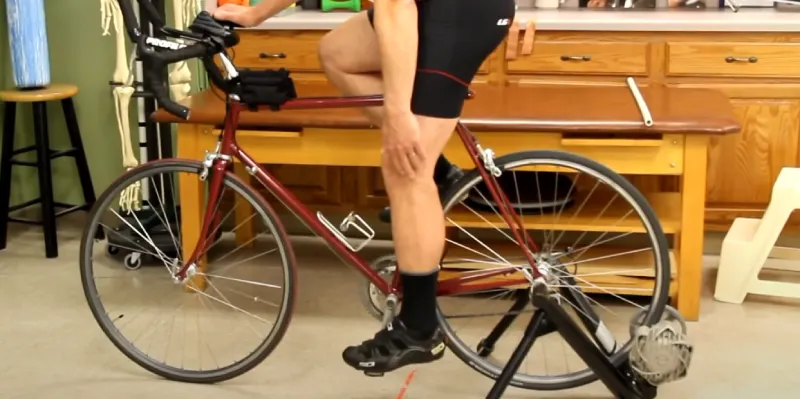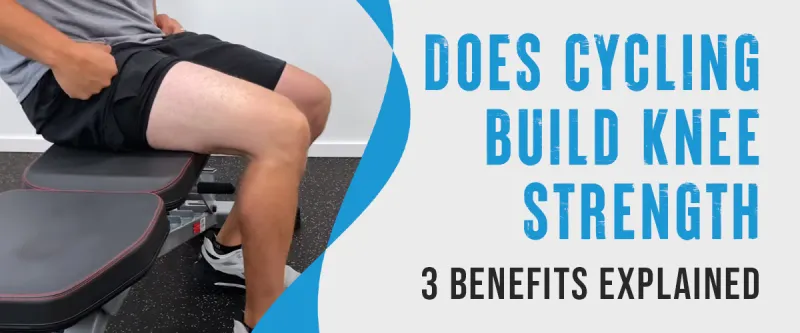Knee cartilage can be maintained by cycling. Cyclists should set up their bikes properly to support their joints. Cycling can also reduce discomfort and improve flexibility and range of motion.
A low-impact exercise like cycling puts less strain on the joints than running or jumping. This makes it a good option for people with knee pain. It can also strengthen the muscles around the knee, which can help to support the joint and reduce discomfort.
We’ll explore the unique benefits of cycling for knee strength and debunk common misconceptions about the sport. Get ready to rev up your knee strength with cycling.
Does Cycling Build Knee Strength? 7 Proven Benefits

Cycling has proven to be particularly beneficial in building knee strength. Cycling is one of the few exercises targeting the quadriceps muscles, crucial in supporting knee health by strengthening the knee ligaments.
✔ Top Pick: Padded Cycling Shorts
Many cyclists wear padded cycling shorts to reduce knee and leg strain by improving comfort and pedaling efficiency.
Mechanics of Cycling that Benefit Knee Strength
The unique mechanics of cycling can be credited for its positive effects on knee strength. When cycling, the knee joint is flexed with every pedal stroke, which results in an increased range of motion. In turn, this will improve knee stability by strengthening leg muscles.
Cycling helps reduce the risk of knee injury by enhancing the dynamic strength of the thighs without putting excessive strain on the joints.
Low-Impact Nature of Cycling and its Effect on Knee Strain
A low-impact exercise such as cycling reduces the strain on your knee joints and makes them stronger than running or jumping. This makes it an ideal activity for individuals with knee pain or arthritis. Cycling can also be customized to individual fitness levels by adjusting the resistance on the cycle or changing the gear ratio.
Whether you choose to cycle on flat terrain or inclines, cycling creates a low-impact environment that protects and strengthens your knee joints.
Cardiovascular Benefits of Cycling and its Impact on Knee Strength
In addition to strengthening knees, cycling has numerous cardiovascular benefits that can contribute to stronger knees. Aerobic exercise such as cycling can improve circulation throughout the body, including the knees.
Increased blood flow to the knees can promote healing and reduce inflammation, enhancing knee health. Furthermore, cycling can help individuals reach and maintain a healthy weight, lowering the risk of knee problems associated with obesity.
Cycling Builds Knee Strength: Useful Tips and Guidelines
Despite its numerous benefits, cycling might harm the knees. We will clarify the misconceptions surrounding cycling and knee health. We will also provide useful tips and guidelines for preventing knee pain and injuries and maintaining healthy and strong knees.
Busting the Myth – Cycling and Knee Health
Contrary to popular belief, cycling is not harmful to the knees. On the contrary, it can build knee strength and improve knee health. Here are some facts to support this claim:
- Low-impact cycling is great for your knees compared to high-impact sports such as running or jumping. This makes it an ideal exercise for people with knee problems or arthritis.
- Cycling helps strengthen the knee muscles, including the quadriceps, hamstrings, and calves. Stronger muscles provide better knee joint stability, reducing injury and pain risks.
- Cycling can also promote better circulation and nutrient supply to the knee joint, helping to maintain healthy cartilage and reduce inflammation.
Factors that Affect Knee Strength in Cyclists

While cycling can benefit knee health, some factors may affect knee strength and increase the risk of knee pain and injuries. The following elements are essential to consider:
✔ Top Pick: Adjustable Bike Saddle
Many riders use an adjustable bike saddle to improve knee alignment and reduce joint stress while pedaling.
Ergonomics and Cycle Fit
- Proper cycle fit and ergonomics are crucial in preventing knee pain and injuries in cyclists.
- A poorly fitted cycle can cause biomechanical stress on the knee joint, leading to joint pain, inflammation, or long-term damage.
- The saddle height, fore-aft, and handlebar height should be adjusted correctly to ensure optimal knee joint alignment during cycling.
Warm-Up, Stretching, and Recovery
- Proper warm-up and stretching before cycling can prevent muscle strains, improve flexibility, and prepare the knee joint for the exercise.
- A gradual and progressive increase in cycling intensity and duration can also help prevent knee pain and fatigue.
- Recovery after cycling is just as crucial as the exercise itself. Rest, hydration, and light stretching can promote muscle healing and reduce stiffness and soreness.
Tips for Maintaining Healthy and Strong Knees
It is safe and enjoyable to cycle for knee health if the following tips are followed:
- Ensure proper cycle fit and ergonomics to reduce knee joint biomechanical stress.
- Gradually increase the cycling intensity and duration to avoid overuse injuries.
- To enhance weak knee stability and strength, incorporate training exercises targeting the knee muscles and ligaments, such as squats, lunges, and leg presses.
- Eat a healthy diet rich in nutrients necessary for joint health, including Vitamin C, Vitamin D, Omega-3 fatty acids, and antioxidants.
- Avoid cycling on uneven or rough terrain that may cause jarring impact on the knee joint.
- Monitor any signs of knee pain, swelling, or discomfort and seek medical advice if necessary.
Knee Strength Can Be Built By Cycling: Contributing Factors

Cycling alone may not be enough to build optimal knee strength and maintain healthy joints. We’ll explore other vital aspects contributing to knee strength and health.
✔ Top Pick: Glucosamine & Chondroitin Supplement
Many people take glucosamine supplements to support cartilage health and maintain strong knee joints.
Nutrition and Hydration
While it may seem obvious, proper nutrition and hydration are vital to promoting knee strength. Here are some key points to consider:
- Stay hydrated before, during, and after cycling. Dehydration can lead to joint stiffness and pain, making maintaining proper form while cycling challenging.
- Incorporate anti-inflammatory foods, particularly omega-3 fatty acids from fish and nuts. Inflammation is one of the leading causes of joint pain and can make it challenging to maintain strong, healthy knees.
- Take supplements like glucosamine, chondroitin, and vitamin D, which benefit joint health.
- Processed and sugary foods can increase inflammation in the body.
Strength Training and Yoga
Cycling is excellent for building endurance and muscle, but incorporating strength training exercises and yoga can further enhance knee strength and improve overall joint health. Here are some exercises and activities to consider:
- Exercises such as squats, lunges, extensions, and leg curls can strengthen the muscles around the knees, providing more significant support and stability.
- Yoga increases flexibility and range of motion, reducing the risk of injury while cycling. Poses like the pigeon, seated forward fold, and the downward-facing dog can benefit knee strength and joint health.
Seeking Medical Advice
Although cycling is a low-impact exercise, it’s still important to seek medical advice if you experience any knee-related concerns. Here are some signs to watch out for:
- Pain, swelling, or knee stiffness lasts more than a few days.
- Knee instability or weakness.
- Popping, clicking, or grinding sounds in your knees.
Conclusion
Cycling is an excellent workout regimen to build knee strength and overall health. With its low-impact nature, unique mechanics, and cardiovascular benefits, cycling offers numerous advantages that other exercises cannot match. We must prioritize proper form and injury prevention measures through ergonomic cycle fits, warm-up, stretching, and post-ride recovery.
Nutrition, hydration, strength training, and yoga are other factors that contribute to knee strength and overall health. Hop on a cycle and pedal to a stronger you to build your knee strength.
FAQs
Is Too Much Cycling Harmful to The Knees?
While cycling is often regarded as a joint-friendly activity due to its non-impact nature, the repetitive pedaling motion can result in various overuse injuries to the knee. It is essential to be mindful of these potential risks to maintain knee health during cycling.
How Do You Strengthen Knees with Cycling After An Injury?
After an injury, you can strengthen your knees by cycling. Start with low intensity and gradually increase duration and intensity. Ensure proper bike fit, wear comfortable gear, warm up, cool down, and take breaks as necessary.


